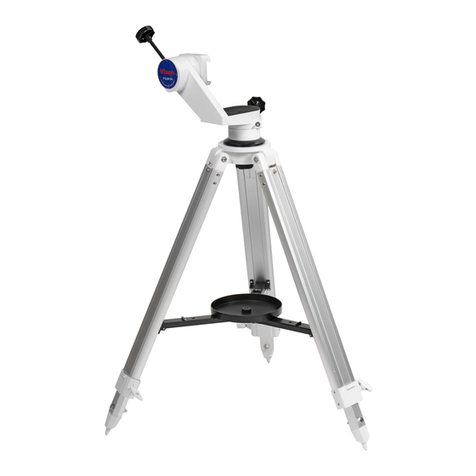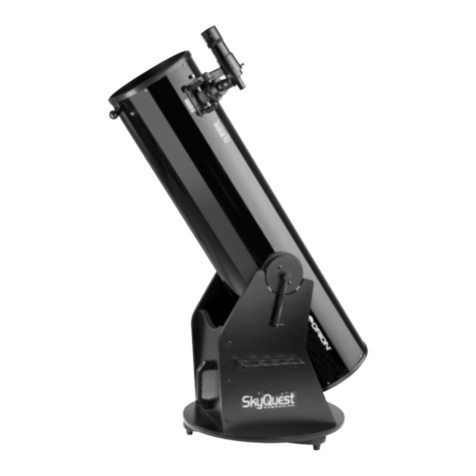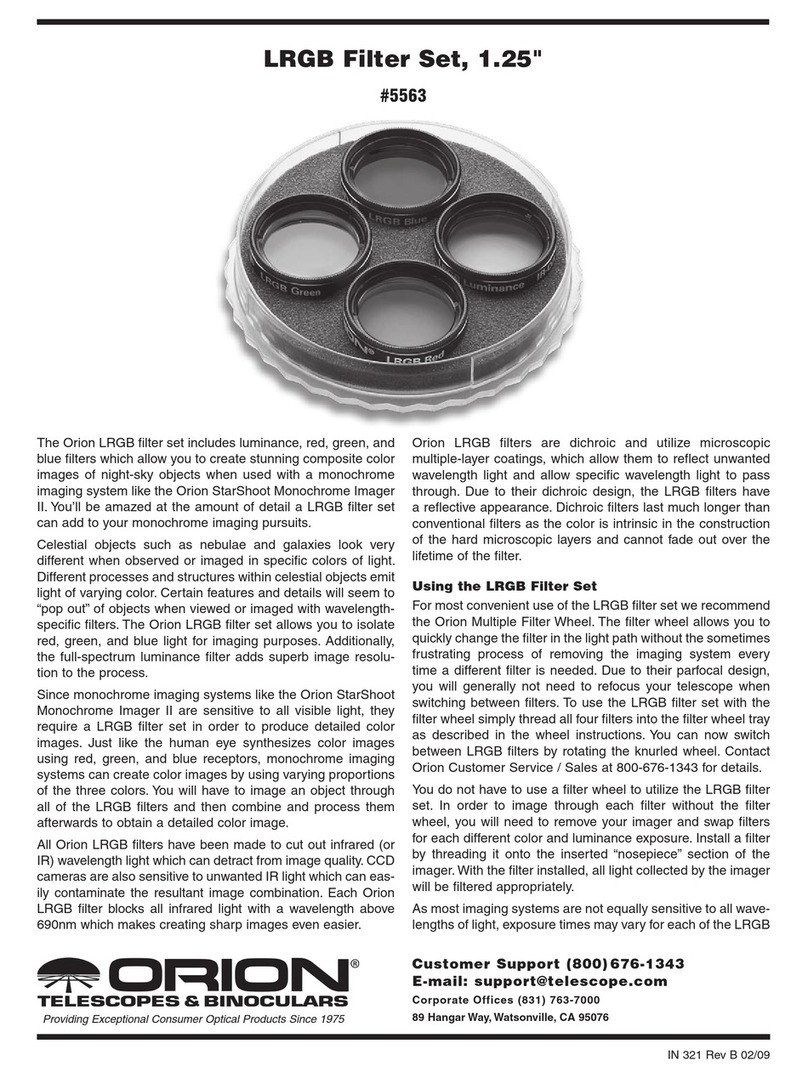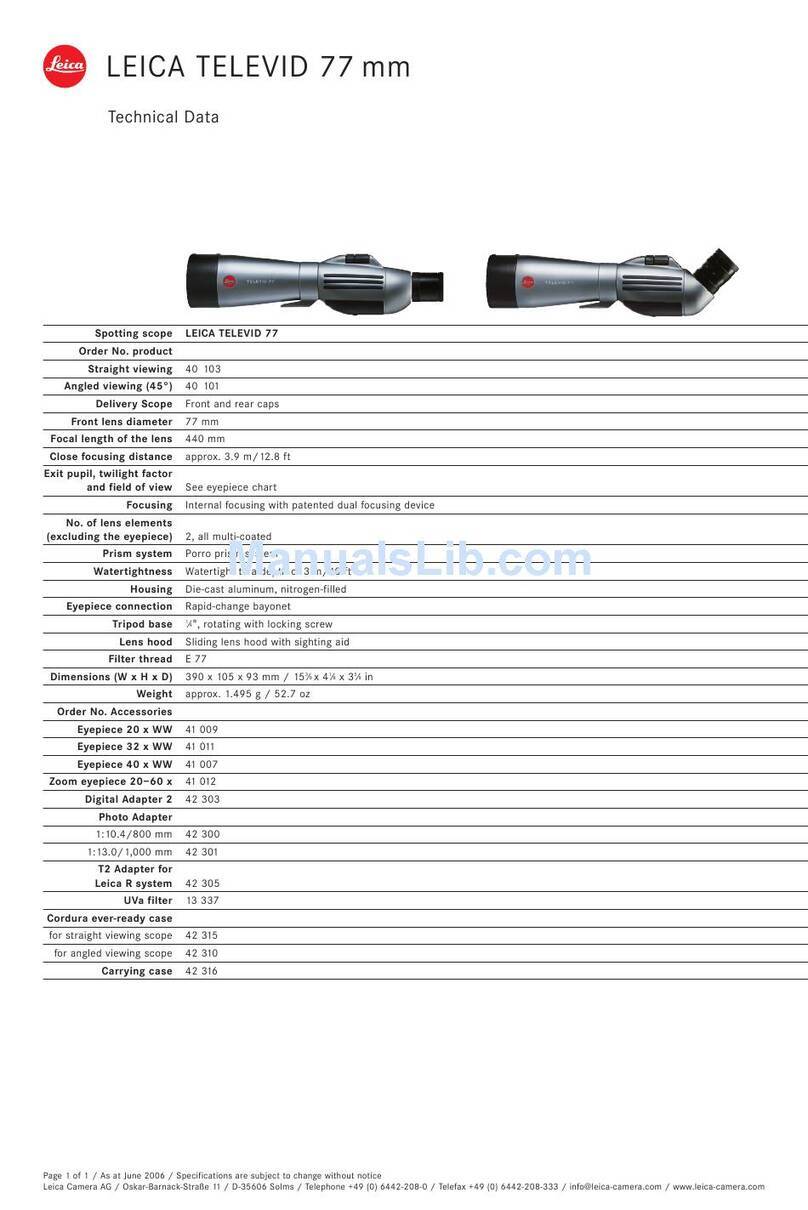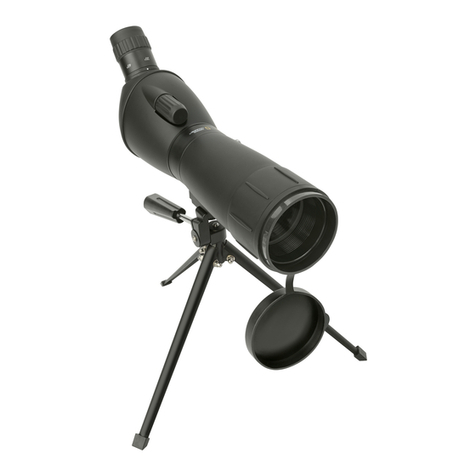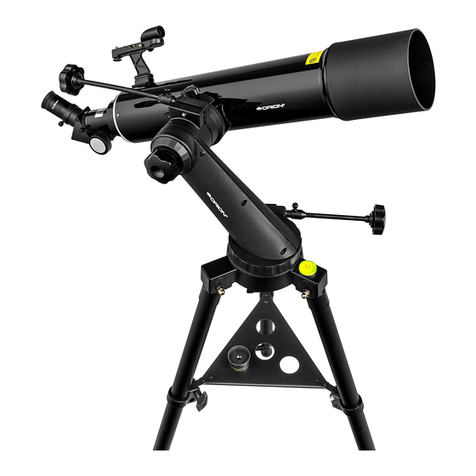NiMAX Omegon 76/900 EQ-2 User manual

1
Instruction Manual
Omegon 76/900 EQ-2
English version 11.2014 Rev A

2
The Omegon® 76/900 EQ-2
Congratulations on the purchase of the new Omegon® 76/900 EQ-2. This small telescope will give
you hours of fun, with its all optical glass lens and super compactness, and it is the ideal companion
to start in the world of amateur astronomy. With this telescope you will be able to see the craters on
the Moon, star clusters, some nebulae a glimpse of the Jupiter disc features and its Galilean moons
and the rings of aturn. We have included many accessories so it will be easy to use this telescope.
1. Included parts
We have included several accessories ha will make he use of he elescope easier and fun, please
ake a look a he lis of he par s so you can iden ify hem in he fu ure.
1. & 2. Two eyepieces 1.25” (31.75mm); a Plössl 25mm and a Plössl 6.5mm eyepiece;
3. 2x magnifica ion Barlow Lens;
4. Red-do finderscope;
2. Getting Started.
I is very simple o ge
s ar ed. Here is how he elescope works. The
elescope should poin o he objec being
observed. The mirror a he bo om of he
elescope’s ube ga hers he objec ’s ligh and
reflec s i o he secondary mirror ha brings
i o he eyepiece. Nex o he elescope’s
aper ure here is he focuser. The focuser
ube moves o ge a precise focused image. A
he focuser one can use he supplied
accessories. Differen combina ions of
accessories give differen resul s, such as
differen image magnifica ions or correc
image. All his will be explained in more de ail
on he nex pages.
3. Assembly.
S ar by se ing up he ripod.
Open he ripod legs as shown (figure 2). Place he ripod ray and hread i (figure 3). You can use
he ray o pu your eyepieces or o her observing accessories. Place he equa orial head on op of
he ripod (figure 4). Nex place he ube rings on he moun (figure 5), igh en i securely, and inser
he coun erweigh shaf by hreading i o he Righ Ascension (R.A.) axis. Inser he coun erweigh
(figure 7), don’ forge o hread he foo -saver ( he screw and washer a he end of he shaf ). Place
he op ical ube by opening he ube rings. Slide i so ha he ube s ays cen red wi h he rings
(figure 8). Ins all he fine movemen handles as shown in he pro ruding shaf s. Remove he wo
humbscrews (figure 10) and ins all he red-do finder (figure 11) as shown, he finder should poin
o he same direc ion as he elescope. Congra ula ions! You are almos ready o use he elescope!
Figure 1. Parts list.

3
Figure 2. Tripod assembly. Figure 3. Tray placement.
Figure 4. Place equatorial head on top of tripod. Figure 5. Place the tube rings.
Figure
6
. Insert fine
shaft.
Figure
7
.
Place the counterweight.

4
4. Start using your megon® 76/900 EQ-2 telescope.
Poin he elescope o a dis an objec
during he day. I is impor an o do his during dayligh , so ha you ge familiarized wi h he
elescope opera ion. A good arge is a church ower, a chimney or a dis an moun ain peak.
Ro a e he focuser knob, so ha he focuser ube moves in and ou . Do his slowly. We sugges ha
you s ar by racking he focuser all he way in and slowly move i ou . Wi h he PL25mm eyepiece
you should be able o ge a focused image easily.
4.1. The Finderscope.
Before we men ioned he
finderscope as a valuable ool o poin he elescope a an objec . To opera e properly, he elescope
and he finderscope should be aligned. The image ob ained hrough he finderscope has a much
broader field of view han ha of he elescope.
4.2. How to align the finderscope?
You have he
house chimney (example men ioned before) cen ered a he elescope eyepiece field of view. Now
look hrough he finderscope. The small red-do a he cen er of he finderscope field of view should
ma ch he cen er of he elescope field of view. Adjus he wo finderscope screws o ge he cross
poin ing o he same objec as he elescope (as shown in Figure 4.2.1.).
Figure 8. Tube placement.
Figure 9. Fine movement handles.
Figure 10. Finderscope placement. Figure 11. Finderscope placement.

5
4.2.1. A dis an objec is cen ered a he elescope’s
field of view. In his example we have a house wi h a
chimney. The chimney is he reference poin o
place a he cen er of he field of view. We firs look
hrough he elescope wi h he lowes magnifica ion
possible (PL25mm should be preferrable), so we
have he wides field of view.
4.2.2. Looking hrough he finderscope (i should be
powered on) we see he same building ,bu in his
case he red do and chimney are no cen ered. We
adjus he finderscope using he wo humbscrews
(figure below) so ha he finderscope red poin
moves sligh ly un il i ma ches he chimney. This is
enough o correc he objec s posi ion in he
finderscope. Trial and error is required o ge a
sa isfac ory resul .
4.2.3. Af er playing wi h he wo findercope
humbscrews and some rial and error, we ge he
finderscope red do close o he cen er (in his case
he chimney). The finderscope is now ready o use!

6
5. Using the accessories, a bit of math to
understand how all it works.
Using he accessories is easy and fun. To
change magnifica ion simply swap eyepieces.
To ge more magnifica ion simply use he
barlow lens. Bu how does all of his work?
5.1. Power (magnification)
Your elescope has a focal leng h of 900mm.
This is approxima ely he dis ance be ween
he elescope lens and i s focal poin (very
similar o he dis ance be ween he focus
poin of a loupe and he loupe lens). This is a
very impor an fea ure, ha allows o
de ermine several in eres ing fac s such as
magnifica ion.
The magnifica ion is de ermined by he
elescope’s focal leng h and he used
eyepiece. You probably no iced ha he wo
supplied eyepieces are PL25mm and
PL6.5mm. This means ha he PL25mm is a
25mm focal leng h eyepiece while he
PL6.5mm is a 6.5mm focal leng h eyepiece.
To de ermine he magnifica ion jus divide he
elescope’s focal leng h by he eyepiece’s
focal leng h. Le ’s give an example for our
elescope and he supplied eyepieces:
Telescope’s focal leng h is 900mm.
PL25 eyepiece’s focal leng h is 25mm.
900
25 = 36
This means ha he PL25 eyepiece provides a
36x power (magnifica ion). This seems low,
bu when you ry i , you will see a brigh
image wi h some (very good) de ails.
5.2. Barlow Lens
The barlow lens is a very in eres ing device. I
is a nega ive lens, ha mul iplies he
elescope’s focal leng h. So a 2x Barlow
mul iplies he original focal leng h by 2x, in
his case 9002 = 1800.
A 3x Barlow lens mul iplies by 3x.
Your elescope is supplied wi h a 2x Barlow
lens. When used wi h he PL25mm eyepiece
you ge 2x he power ob ained before
362 = 72
5.3. Erecting lens (not included)
The erec ing lens ge s you an uprigh image
view wi h he elescope. I also adds some
power like he barlow lens. The supplied
Erec ing Lens provides an ex ra 1.5x power.
5.4. Diagonal Mirror (does not apply to this
model)
This diver s he ligh coming from he
elescope o an angle of 45 or 90 degrees. I is
useful because i provides a more confor able
posi ion when observing.
Here are some examples on how o use he
accessories.
Some possible accessory combinations
Terres rial
View
Moon
Deep Sky
Jupi er and
Sa urn
Barlow Lens 2
x
PL
25
mm
Eyepiece
Yes
Yes
PL6.5mm
Eyepiece
Yes
Yes
Power
Does not apply
139
x
3
6
x
7
2
x

7
6. What can been seen with this telescope?
Below you will find some examples of wha you can expec o see when using his elescope.
6.1. The Moon is one of he mos spec ular objec s
o be seen hrough a elescope. Even a small
elescope will reveal high de ail of he Moon’s
surface. You will be able o see he cra ers on he
Moon’s surface and o her fea ures like he Marea.
The moon is a very brigh objec . I is be er o
observe i when he Moon is no full. Try he
crescen Moon and look for fea ures along he
ermina or (be ween illumina ed and dark surfaces).
6.2. Jupi er is he bigges plane of our solar sys em.
I is also one of he favori e arge s for beginners.
Galileo was able o discover ha he four iny do s
ha urn around he plane were in fac par of
Jupi ers sys em of moons. Wi h his elescope you
will no only be able o see Jupi er’s plane disc wi h
i s wo major discernible bands, bu also i s bigges
moons, Io, Europa, Ganymedes and Callis o.
6.3. The “lord of he rings” of he nigh skies,
Sa urn is by far he mos popular arge for
small elescopes. Sa urn’s rings are
discernible even a 60x magnifica ion. In a
very good nigh you will be able o see he
Cassini’s division ( he darker band on he
Sa urn’s rings).

8
7. Troubleshooting and frequently asked questions
Q: I get a mirrored view of the object . Like if they were rever ed, and
R
how up like
ᴙ
R: This is caused by he elescope’s mirrors. To ge a correc ed image i is necessary o use he
correc ing lens and he eyepiece as shown below. Please no ice his elescope is no designed for
erres rial viewing.
Q: I u e the finder cope to point to object but I alway mi the target.
A: You probably need to realign the finderscope. Please proceed as described in 4.2.
Q: When I u e the barlow len and the PL6.5mm eyepiece the image i o dark I can hardly ee
anything.
A: Power should be used with moderation. It depends on how stable the atmosphere is, too much
turbulence causes image distortion. Usually the limit is 2x for each millimeter of the telescope
aperture. In this case the telescope has an aperture of 76mm, so in a very good night you should be
able to reach 154x. The more magnified the image is, the darker it gets.
Q: I my tele cope compatible with other eyepiece ?
A: Omegon telescopes are compatible with all telescope eyepieces from different manufacturers as
long as the eyepiece is a 1.25” (or 31.75mm) size eyepiece. If you would like to test an eyepiece from
a fellow astronomer go ahead. Different eyepieces provide different visual experiences.
Q: I want to u e my tele cope to take picture .
A: This telescope is designed for visual use. It doesn’t mean it can’t be used for photography, however
it will be hard to get high quality pictures with this telescope. If you have a smartphone you can shoot
the Moon or some terrestrial objects. earch online for digiscoping and afocal photography.
Q: The tar only appear a point in the tele cope.
A: tars will always only appear as points, even in the largest telescopes in the world. It is more
interesting for beginners to observe two-dimensional objects, such as the Moon or planets. Once you
find these, you will be able to start learning about the astronomical calendar.
Q: I would like to ob erve the Sun.
A: An appropriate solar filter, placed over the objective, is essential for observing the sun. These are
available as plastic foil or glass filters. They only allow a tiny and harmless fraction of sunlight into
the telescope, when securely positioned over the objective, allowing you to observe the sun in
complete safety. Eyepiece solar filters (not available from us) should be avoided at all costs as they
are considered unsafe.
Note: Never look directly at the un through a tele cope without an objective olar filter!
Q: I can’t ee anything when I look through my tele cope.
A: The telescope is only suitable for astronomical observing and when used outside at night.
Observing from inside the house or during the day usually is not possible.
The dust caps must first be removed and an eyepiece inserted before you can start observing. Are you
sure you have removed all the dust caps, not just the small ones? If you have not, then no light will
enter the telescope and everything will appear black.

9
Questions? Visit our website www.astroshop.eu and drop us a line* nimax Gmbh Otto-Lilienthal-Str. 9 D-8 899 Landsberg am Lech
Popular Telescope manuals by other brands

Bresser
Bresser JUNIOR 45/600 AZ instruction manual
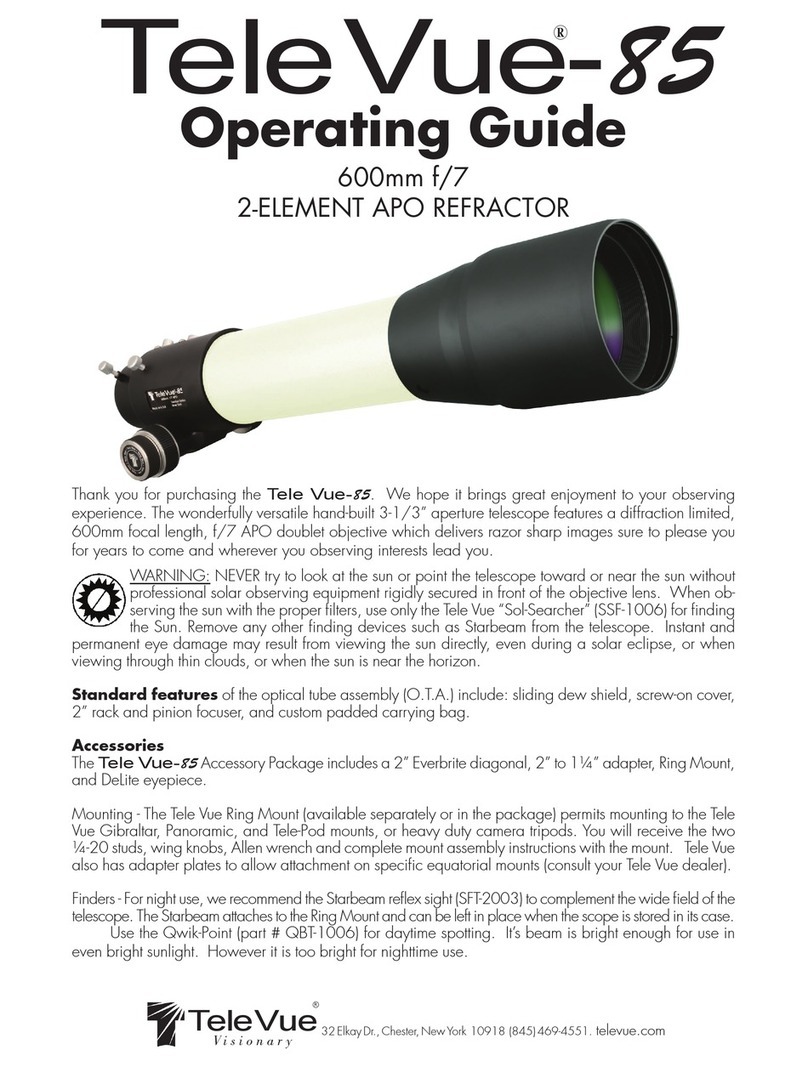
TeleVue
TeleVue 85 operating guide

Meade
Meade 2045 operating instructions

ORION TELESCOPES & BINOCULARS
ORION TELESCOPES & BINOCULARS SpaceProbe 3 Altaz 9845 instruction manual
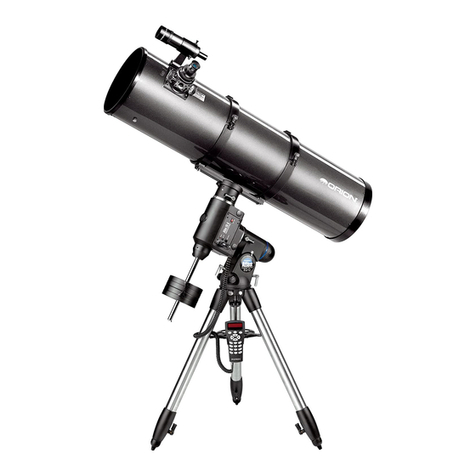
Orion
Orion ATLAS 10 EQ manual
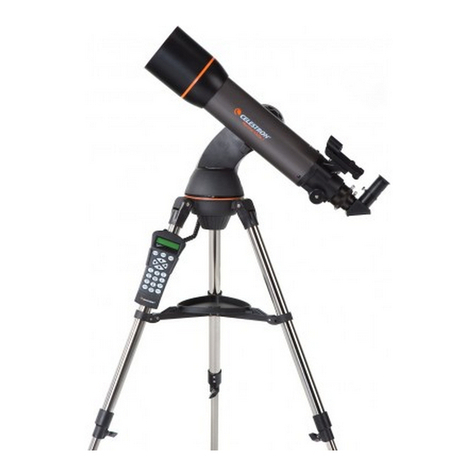
Celestron
Celestron SkyProdigy 102 instruction manual

